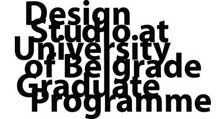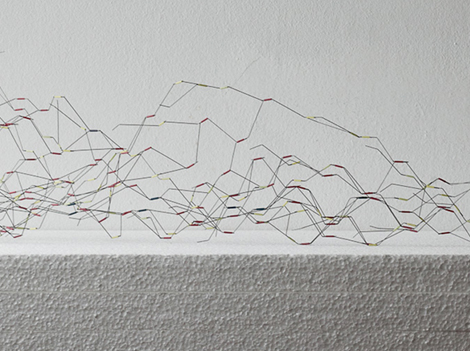NEW MEDIA INSTITUTE
Module: Design Studio M4.1 2012/13, 18ECTS
Djordje Stojanovic and Milutin Cerovic
Graduate Programme, Faculty of Architecture – University of Belgrade
Throughout this semester, in continuation with the agenda form the past two years, we will be investigating into the potentials which have emerged from the ongoing convergence between contemporary architecture and the new media. The term “new media” is primarily related to communications and encompasses broad spectrum of innovations based on the use of digital technologies. It has been said many times that such novelties have led to the creation of new social, cultural and economic structures, which in turn enable and demand, at the same time, fundamental changes of spatial environments. Over the past two courses along the same agenda, we have explored programmatic context of institutions dedicated to culture and art in 2011, and institutions for archiving and distributing information in 2012. In this term, programmatic framework refers to the New Media Institute which may be interpreted in the number of ways. It may be observed through primarily educational orientation, which could be synchronized with the host of other programs and spaces for work, art and communication, fun and recreation.
The challenge lies in the enabling of the educational institutions as essentially networked organizations which may not be placed into any of the existing typological classifications. The programmatic framework of The New Media Institute prompts the need to develop understanding of relations between architecture as a solid and determined spatial condition and something that is ephemeral and it is not related to a specific location, the media.
The site for the project may be selected from the variety of opportunities found at the vacant areas of the Block 45, located at New Belgrade along the Sava River. Predominantly residential neighborhood built concomitantly approximately half a century ago, offers unexpected opportunities for the implementation of new programs and structures. For instance, there could be an opportunity to develop a single building, or perhaps to form a strategy based on the infrastructure with distributed and temporal pavilions, or to form a design intent based on the systemic extension of the existing buildings.
The existing condition on site is characterized with openness and void, seen not only as the opposite to the built form, but also as an operative system of flows and diverse scenarios of occupation. The relevance of the existing planning legislation is intentionally reduced in the design brief to provide for more comprehensive learning process. In contrast to focusing on traditionally accepted categories in architectural design such as building, plot and use, studio will be investigating design techniques and mechanisms to allow for spatial adaptations according to specifics of the unfolding activities and changing environmental conditions. In addition, we will pose questions on how to meet high demands on energy criteria and will test disciplinary boundaries with the inclusion of diverse and comprehensive sets of information throughout the design process.
Students: Ilic Bogdan, Divac Uroš, Sekulic Milica, Arsic Ljubica , Mazic Rastko, Aleksandar Bursac, Jankovic Branka, Ðuric Lazar, Todorovic Dejan , Čolovic Tijana, Opacic Petar, Mijic Miona, Aleksandar Jovanovic, Amayu Wakoya
Modul M4.1 Studio projekat, 16 ESPB
Naziv zadatka: Institut za nove medije
doc. Djordje Stojanović, ass. Milutin Cerović
Master akademske studije – Arhitektonski fakultet Univerziteta u Beogradu
Tokom ovog semestru bavićemo se istraživanjem potencijala koji nastaju usled približavanja i nastanka međusobne uslovljenosti između savremene arhitekture i novih medija, u kontinuitetu sa agendom koju razvijamo kroz rad u studiju tokom prethodnih godina. Termin „new media“ odnosi se prvenstveno na komunikacije i obuhvata širok spektar inovacija koje se zasnivaju na digitalnim tehnologijama. Već mnogo puta ranije je ukazano da ovakve novine imaju implikacije i na formiranje socioloških, kulturoloških i ekonomskih struktura, koje za uzvrat zahtevaju i omogućavaju nastanak fundamentalno izmenjenih prostornih okruženja. U prethodna dva semestra, programski kontekst postavljenih zadataka je obuhvatao potrebe institucija za kulturu i umetnost, kao i arhiviranje i distribuciju informacija. U ovom semestru programski okvir zadatka odnosi se na potrebe instituta za nove medije, koje mogu biti interpretirane na više načina. Zadatak može biti sagledan kroz prevashodno edukativnu orijentaciju ali i koegzistenciju sa drugim kompatibilnim namenama čije potrebe mogu obuhvatiti prostore za rad, umetnost i komunikaciju, zabavu ili rekreaciju.
Izazov leži u razumevanju fenomena edukativnih prostora kao suštinski umreženih organizacija koje se ne mogu u potpunosti staviti u okvire jedne, tipološki određene, institucije. Programski okvir instituta za nove medije zahteva razjašnjenje odnosa arhitekture, kao discipline koju prvenstveno vezujemo za ostvarivanje prostornih determinisanosti, prema nečemu što je efemerno i nije isključivo vezano za jedno određeno mesto, medijima. Cilj ovog kursa je razvoj istraživačkog pristupa projektovanju i sticanje kritičkog odnosa prema materijalnom domenu arhitektonskog objekta.
Prostorni okvir projekta čini neizgrađeni deo novobeogradskog bloka 45, koji se nalazi uz reku Savu. Pretežno stambena namena i pravilna matrica ovog okruženja nude možda neočekivane mogućnosti za implementaciju novih programskih sadržaja i struktura. Na primer, jedna mogućnost leži u formiranju projektantske strategije u vidu samo jednog centralizovanog i permanentnog objekta, druga opcija predstavlja postavku infrastrukture sa nizom efemernih objekata, treća mogućnost odnosi se na formiranje ekstenzije već postojećih objekata…
Jedna od osnovnih karakteristika postojeće morfološke situacije na zadatoj lokaciji jeste otvorenost i prisutnost praznine, ne samo u smislu negativa izgrađene situacije već u smislu operativnog sistema tokova koji omogućavaju formiranje raznovrsnih scenarija okupacije prostora. Postojeća planska i pravna regulativa će biti zanemarene u kontekstu ovog zadatka kako bi bilo omogućeno sticanje određenog projektantskog znanja. Za razliku od tradicionalno uspostavljenih projektantskih kategorija kao što su objekat, parcela i namena studio će razvijati tehnike i mehanizme za projektovanje prostora/okruženja koji se mogu transformisati i prilagođavati prema relevantnim spoljašnjim uticajima ili aktivnostima koje se u njima odvijaju.
Image credit: Nikola Milanović & Katarina Mijić 1112M5





